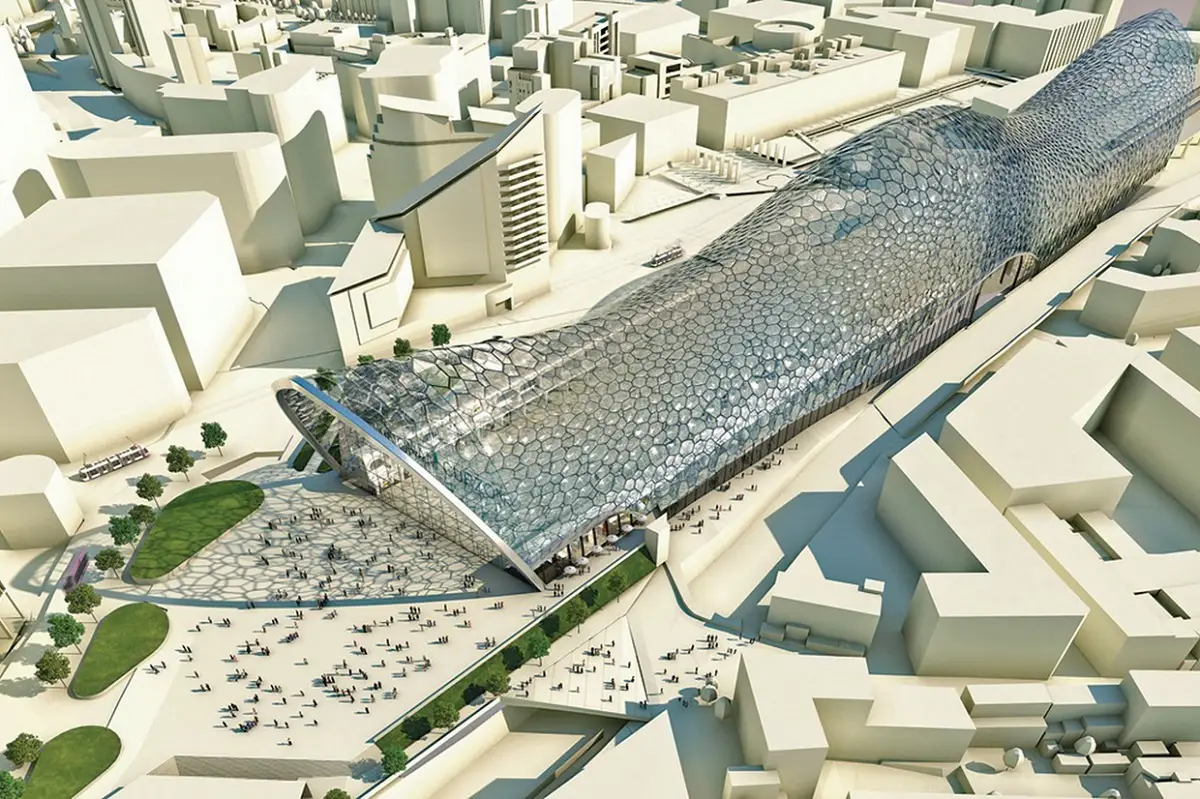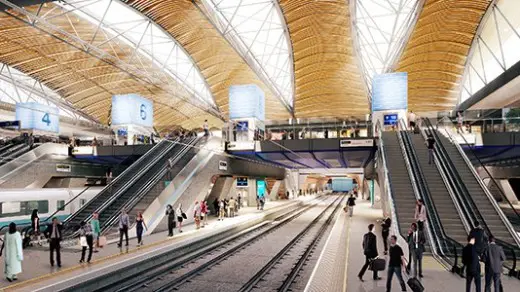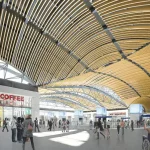ThinkStation Design Council Report, British Railway Architecture, England, Network Rail UK Architects News
ThinkStation Design Council Report UK
30 June 2020
A new generation of passenger hubs in UK
Design Council publishes report into future design of local stations
A report into the future of railway station design commissioned by Network Rail was published 29th of June 2020 by Design Council. ThinkStation provides a framework for the future design of local stations following a wide-reaching engagement exercise completed earlier this year. There are currently 2,000 local stations (categories D, E and F) in Great Britain, making up around 80% of Network Rail’s station ownership.
Birmingham Curzon Street HS2 Station building design:
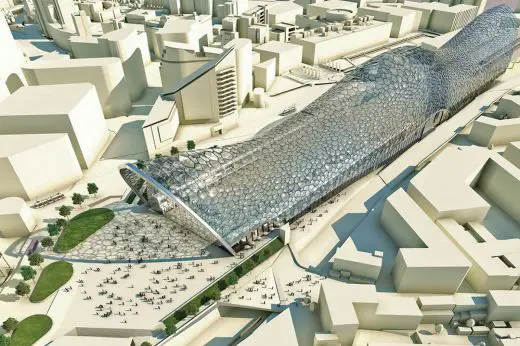
image courtesy of architects
Design Council UK Railway Report – ThinkStation
Design Council’s engagement programme centred on 11 workshops with 324 attendees from 120 organisations in four major British cities. Its findings put forward priorities for designing a passenger hub of the future, next steps for using this learning and wider strategic advice for Network Rail and the rail industry.
The nine priorities that will guide the future design, development and procurement of local stations are:
1. Support existing and new communities in their local area
2. Reflect and embody local character and heritage
3. Provide consistent quality of space and service
4. Establish connections with and between the town centre and/or the high street
5. Celebrate, improve the quality of and/or provide access to green and open spaces
6. Be welcoming and facilitate inclusive travel
7. Support and better integrate cross modal transport
8. Help to address climate change
9. Ensure longevity by accommodating changes of use, capacity and trends
Sue Morgan, Director of Architecture and Built Environment at Design Council, said: “Better stations will improve millions of people’s lives and boost the quality of surrounding spaces through economic renewal, social enhancement and environmental restoration. Most of us would naturally accept these themes as priorities already but this report demonstrates a clear evidence base, sets out ideas for bringing them forward and establishes Network Rail’s expectation that each one of them is a priority that will be present in future plans for all local stations.
New HS2 Terminus Euston Station Building:
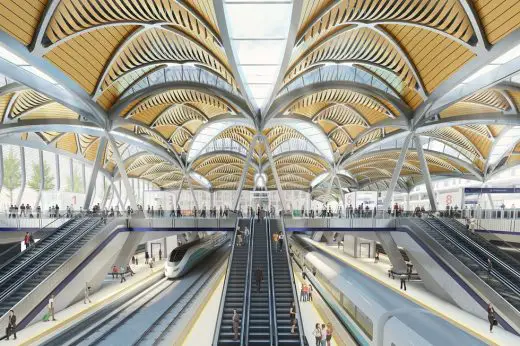
image courtesy of architecture office
“The rail industry is right to keep championing good design and applying design thinking when facing strategic opportunities and challenges, but it is hard. Station design varies greatly, and improvements need resourcing, which is now more of a challenge than ever. But long-term our stations need to give passengers a better experience and they need to make more substantial contributions to global issues, such as climate change, and local needs, such as high street vitality. This report makes the task clearer for everyone involved.”
Anthony Dewar, Professional Head of Buildings and Architecture at Network Rail, said: “We wanted to put passengers and stakeholders at the heart of the next generation of railway stations. The ambition here is to raise the quality of design across our network as well as responding to the evolving role of infrastructure within communities.
80% of our stations need to be integrated into smaller urban and rural contexts and this report creates a framework that can then be made appropriate to each community and its needs. This report envisions stations that value communities, connectivity and stronger placemaking and we want to make that happen through the upcoming competition and across our portfolio.”
The ThinkStation report and its findings will inform the brief and judging for Network Rail’s international design competition for medium and small stations across Great Britain, as well as shaping future design work and further community engagement. The competition, which will be run by RIBA, will launch in July.
New HS2 Terminus Euston Station entrance canopy design:
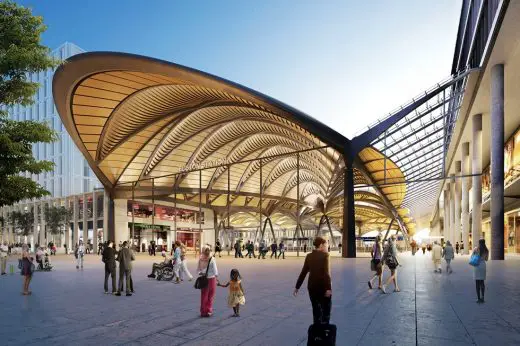
image courtesy of architects office
About Design Council
Design Council’s mission is to make life better by design. We work with people to create better places, better products and better processes, all of which lead to better performance.
We commission pioneering evidence-based research, develop ground-breaking programmes, and deliver influencing and policy work to demonstrate the power of design and how it impacts three key areas of the economy: business innovation, places and public services. We bring together non-designers and designers – from grassroots to government – and share with them our design expertise to transform the way they work.
ThinkStation Design Council Report information received from the Design Council UK
Previously on e-architect:
UK Railway Station Design
HS2 decision will destroy precious wild places
HS2 Station Designs: High Speed Two Buildings
The Wildlife Trusts call for a redesign
Today the Government gave the green light to the High Speed 2 rail project, without acknowledging the devastating impact on the hundreds of precious wild places and the wildlife that depends on them – that lie in the path of the route. The Wildlife Trusts recently published a report evidencing the vast scale of the destruction and impact that HS2 will cause to nature.
‘What’s the damage? Why HS2 will cost nature too much’ assessed the broad range of impacts across all phases of HS2 on protected wildlife sites, species and landscape restoration projects.
New HS2 Station Building Architects
New HS2 Terminus London Euston Station building design:
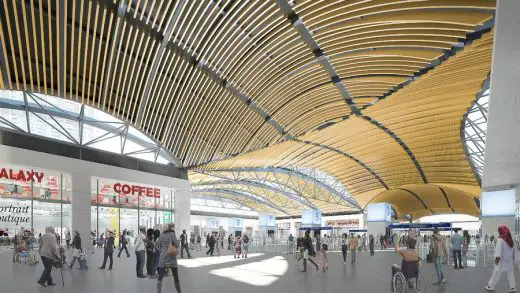
image courtesy of architects office
HS2 Euston Station London Terminus
New HS2 Terminus Euston Station Plans
Design: Arup / Grimshaw
New HS2 Terminus Euston Station building design:
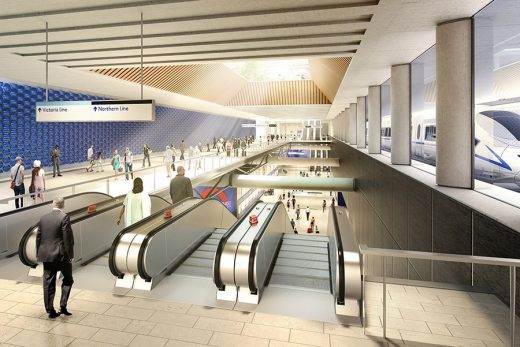
image courtesy of architects office
HS2 Terminus Euston Station
Design: Arup / Grimshaw
HS2 – UK government website
UK Railway Station Architecture
London Railway Station Buildings
Architecture in the UK Capital City
Comments / photos for the ThinkStation Design Council Report- New Railway Architecture page welcome

